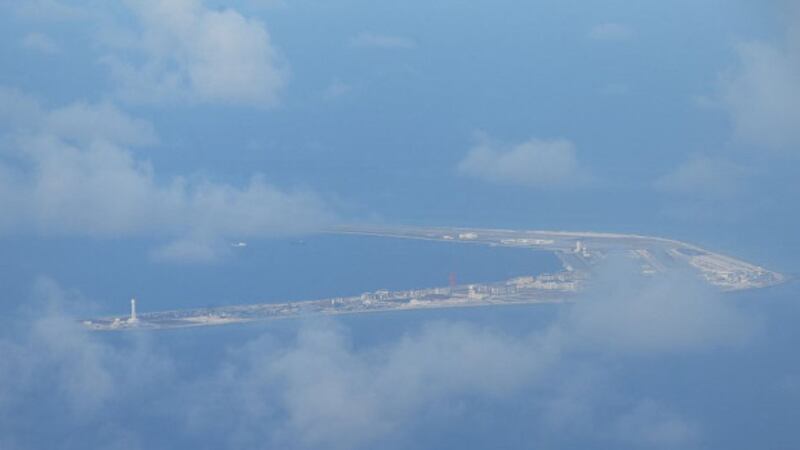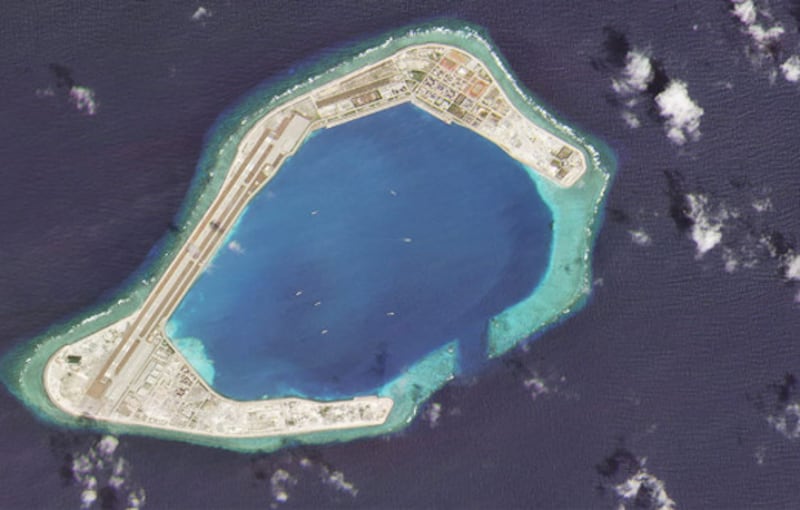After a prolonged stand-off with Vietnam, Chinese vessels are again monitoring and harassing energy exploration efforts by another claimant country in the disputed South China Sea, according to a report by a Washington-based think tank. This time it is Malaysia that’s on the receiving end.
A report from the Asia Maritime Transparency Initiative (AMTI) revealed that in October 2019 an exploratory vessel, contracted to Malaysian state-owned oil company Petronas, and its offshore supply vessels entered an area of the South China Sea claimed by Vietnam, China, and Malaysia.
In response, China Coast Guard ships identified by AMTI as the Haijing 5202, Haijing 5403, Haijing 5203, and Haijing 5305 patrolled around the Petronas-contracted vessel consistently throughout December and January. They left it alone in early February only after an appearance from the Royal Malaysian Navy and Malaysian Maritime Enforcement Agency.
But the let-up didn’t last. Using online ship-tracking software, Radio Free Asia has learned that fishing vessels affiliated with China’s People’s Armed Forces Maritime Militia (PAFMM) took their place.
The Lurongyuyun 50018 and Lianxiachulu 008 were still sailing unusually close to the same offshore supply vessels as of Feb. 24, seemingly harassing them as they maneuver within China’s nine-dash line, which is Beijing’s rough demarcation of its expansive claims in the South China Sea.
The Lurongyuyun and Lianxiachulu, notably, share the same maritime mobile service identification number, a tell-tale sign that one or both of them are practicing GPS-spoofing to hide their presence.
This follows a pattern of behavior by China Coast Guard vessels and fishing boats operating far from Chinese ports, evading detection through GPS-spoofing and often resting during long voyages into the South China Sea at Chinese-built facilities constructed on disputed features. This was most prominently seen during the recent deployment of coastguard ships to Vanguard Bank and Second Thomas Shoal.
As reported by AMTI, Chinese ships can only sustain pressure campaigns far from the Chinese mainland if they can dock and replenish at key artificial islands such as Fiery Cross and Subi Reef.
China Coast Guard vessels and maritime militia had previously interrupted oil drilling efforts by the Russian company Rosneft within Vietnam's exclusive economic zone in mid-June.
And at the same time that China Coast Guard ships were monitoring Malaysian energy exploration efforts, a flotilla of PAFMM and other coastguard vessels sailed within the exclusive economic zone of Indonesia's Natuna Islands.

Vietnam fields maritime militia
In the most recent incident revealed by AMTI, Malaysian exploration also drew in the presence of Vietnamese fishing boats, who are part of a growing Vietnamese maritime militia presence in the South China Sea.
There is less information on the Vietnamese maritime militia than there is on the more prominent PAFMM. However, Vietnam's 2009 Law on Militia and Self Defense Force explicitly calls for a 'marine militia' that, as with other types of militia, would constitute a part of Vietnam's armed forces and be responsible for defending fishing vessels engaging in commercial activities.
The Vietnamese maritime militia has been built up since then, according to Derek J. Grossman, a senior defense analyst with the U.S.-funded think tank RAND Corporation, and now constitutes a mix of commercial fishing vessels and marine safety vessels under Vietnam's Ministry of Transportation. AMTI reported Vietnamese fishing vessels observed, but did not intervene, in Malaysia's exploration activity.
"One of their missions is to report back," Grossman explained. "Vietnam, in terms of maritime domain awareness capabilities, is not very good. They don't have satellites like China does. They're using old school techniques. They're using tried and true techniques."
Referencing a report on Vietnamese maritime militia activity near Hainan publicized by the South China Sea Probing Initiative, a think-tank run out of China's Peking University, Grossman elaborated that this is in keeping with the militia's purpose. "It's not a crazy idea to go up to enemy lines," he said, referring to the borders of China's territorial waters.
The creation of Vietnam's maritime militia is also closely linked to the involvement of China's PAFMM in maritime disputes, which at times has been aggressive.
“I think it’s entirely focused on the Chinese maritime militia. When you look at how many countries around the world have fishing militia, I’ve only been able to find China and Vietnam. It’s not something other countries do because there’s no reason for it,” Grossman said.
Vietnamese fishing vessels purported to be part of the militia were involved in several high profile maritime disputes, most notably during the 2014 stand-off between China and Vietnam over the Hai Yang Shi You 981 oil rig. In that incident, a Chinese fishing vessel rammed and sank a Vietnamese one.
However, there is evidence that the use of maritime militias on both sides is a strategy to prevent a greater conflict between the two countries’ navies. China has maintained plausible deniability over whether its fishing fleets are acting at the behest of its armed forces.
“Fishing boats ramming fishing boats could then bring in the coast guard, which could then bring in the Navy. But I think both sides, China and Vietnam, think that it de-escalates,” Grossman explained, “Neither of them are admitting they use them for military purposes… in a scenario, they can say ‘This is civilian-on-civilian. We can keep the situation bottled up.

Reported by RFA, an online news service affiliated with BenarNews.
